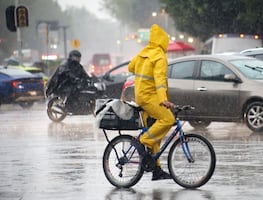Más Información

Reforma a la Ley de Amparo divide opiniones en el Senado; especialistas advierten riesgos y beneficios

Dan 11 años de prisión a “El Haza” por atentado a Ciro Gómez Leyva; se le acusa de tentativa de homicidio calificado
Forty years ago, doctor Enriqueta Velarte arrived on Rasa Island , located in the Sea of Cortez , to observe and research seabirds living in that small 141-acre piece of land. Once she entered that magical site in her student years, she couldn’t stay away from it. It became her life.
Every year, in company of students and volunteers, she arrives at the biological station to set up the necessary working material, solar panels, and provisions to allow her to stay from April till June , during the birds’ nesting season. Over time, the biologist from the University of Veracruz and her team have banded thousands of specimens in order to identify them; they have observed their behavior, the way they fish, and their eating habits. Later on, during the 1990s , they noticed a significant decrease in the number of nests.
With the aim of finding the causes, Velarde formed an interdisciplinary team with doctor Exequiel Ezcurra , an ecologist and botanist specialized in arid zones who works as a professor at the University of California, in Riverside . They both studied the correlations between adult birds, chicks, weather, and the availability of their main food source: Sardines.
They found that the El Niño atmospheric phenomenon , which increased water temperature at sea, had caused a sardine shortage, deeply affecting the food chain. Minor pelagic fish such as the mackerel and the anchovy , require cold water currents from the bottom of the sea in order to thrive, given their high levels of plankton and other nutrients, according to Seabird ecology ’s study “ El Niño anomalies, and prediction of sardine fisheries in the Gulf of California (2004) .
Centenary Migration
Starting the new millennium, however, the sardine industry’s over-exploitation aggravated the decline in sardine populations, affecting birds such as the Heermann’s Gull and the elegant tern , as well as sea mammals that have migrated to the Gulf of California for hundreds of years to feed on this type of fish. The proportion of the over-exploitation is significant: Every year, more than 500,000 birds arrive in search of sardines, a high-fat meal, only to find themselves competing with an industrial fleet that produces an average of 533,000 tons a year (the equivalent of filling 20 stadiums with sardines), according to official sources, out of which 75% is used to produce fish meal for the livestock sector and, more recently, for aquaculture and mariculture .
The sardine industry is subsidized and, between 2010 and 2017 , it received at least 257 million pesos from the federal government. However, not only the environmental consequences have been ignored, but also the impact of this unbridled industry on artisan and sport fishing, as well as local tourism.
In 1964 , the Rasa Island was declared a Natural Reserve and bird sanctuary by Mexican authorities for being the seabirds’ vital space. The elegant tern arrives from the coasts of Chile , and the gull comes from Canada , traveling thousands of miles. “Half a million of these birds are concentrated on the island, which is 95% of their entire population,” said Ezcurra .
In order to study them, scientists assemble a sort of mesh paddock where they put the birds during their first six weeks of life and band them. In so doing, they are able to monitor their reproductive success by studying the number of nests, eggs, surviving chicks, and nurturing habits. Over a decade, they have banded 36,000 specimens .
“We have been able to follow these birds throughout their entire lives. Some of the oldest ones we have registered are now 28 years old ,” he stated.
Each time they arrive on Rasa Island, the birds dive into the water to get a sense of temperature, exsurgence depth, and the density of sardine schools.
“They can feel the amount of sardines there are, as well as the oceanographic conditions. Who is to tell what sort of algorithm operates in their heads? But somehow, they always make the right choice. If it’s a bad year, they just leave!,” emphasized the environmentalist, who has developed a very important interdisciplinary research.
The parents’ corporal traits have a direct influence on nest sizes, plumage, and reproduction. For instance, both Heermann’s gulls and elegant terns have two hatchlings per nest and, on average, only one of them survives . However, if conditions are adverse, they abandon their eggs and chicks because they know that, during famines, it increases their chances of survival, according to the investigation: “ Effects of parental age and food availability on the reproductive success of Heermanns’ Gulls in the Gulf of California, 2009 .”
To this situation is added the fact that in 1988-1989 , the industry over-exploited the natural resource, causing a strong decline in the sardine population during the following years, according to a report on “The Collapse of Sardine Fishing in the Gulf of California,” made by the dataMares initiative.
“Last year’s fishing efforts had notorious effects. Since they fished too many adults, the next spawning was smaller, generating less broods and diminishing the birds’ captures,” Velarde explained.
The Natural Numbers initiative at the Scripps Institution of Oceanography in San Diego indicates that each bird consumes around 20 sardines a day (of about 120 grams each) , which means that half a million birds would require a total of 60 tons a day . However, the sardine industry fleet can fish up to 3,000 tons in just one night .
According to the " Warm oceanographic anomalies and fishing pressure drive seabird nesting north study of 2015 ," the “pulses of migration” are caused by changes in ocean temperature and sardine over-exploitation. In the past 18 years, elegant terns and a few seagulls have started to change their conduct, migrating to other places. The change was timid at first, but now, there is a massive migratory movement toward the San Diego bay, the port of Los Angeles, Dana Point, and Long Beach, in California , where sardine fishing is regulated.
Ezcurra suggests that, since the year 2000 , the birds have been seeking “nesting alternatives,” and settling in post-industrial sceneries, surrounded by ships and industrial containers. Furthermore, the seabirds are suffering a demographic crisis caused by a decline in their breeding stock during the past decade. “Birth rates have declined considerably,” Velarde warned.
In the case of terns , around 300,000 specimens were registered , from which only 30,000 migrated to California in 2012 . “They represent 10% of the population nesting in Mexico . As for the remaining 90% , we are not sure what happened, because they didn’t return to the country. As for the Heermann’s gull, we don’t know much either, and we have only seen two or three nests lying around,” he stated.
“It is not only the birds at the Rasa Islands that are affected, but also every other bird in the region, as well as sea animals such as whales, dolphins, seals, and many types of fish ,” Velarde added. Other species, such as the brown pelican, the blue-footed booby, the magnificent frigatebird, the double-crested cormorant, the black-headed gull, the yellow-footed gull, the ring-billed gull, the royal tern, the western grebe, the least storm-petrel, the eared grebe, the black-vented shearwater, and the pink-footed shearwater .
If you want to find out more about seabird species and their distribution in the American continent, you may consult the naturalista database , which was made in cooperation with Mexico’s National Commission for the Knowledge and Use of Biodiversity (CONABIO) .
Velarde and Ezcurra shared their conclusions with the sardine industry, arguing that seabirds are not only able to predict the potential success of commercial fishing seasons, according to their research “ Seabird diet predicts following-season commercial catch of Gulf of California Pacific Sardine and Northern Anchovy (2014) ,” but also the impact of the over-exploitation: “There is a circular relation in which captures from the previous year have a direct effect on the seabirds’ diet, which in turn may predict potential captures for the following year. Since 1999 , we’ve known that fishing has a very important effect on the environment,” Ezcurra pointed out.
A Second Home
A few weeks ago, Enriqueta Velarde returned from her 40th visit to Rasa Island, which she considers to be her second home. She observed significant changes and a decrease in the number of seabirds. During her stay at the arid maritime region, she has witnessed humpback whale courtships and dolphins following her boat. In her eyes, the Gulf of California will always be a magical and unpredictable place where anything can happen.
Velarde and Ezcurra agree that, if actions are not taken soon, the situation will become aggravated to a point where it will deal an irreversible damage to the environment .
*This article is part of the science journalism project promoted by Iniciativa DataMares (datamares.org), which seeks transparency, dissemination, and understanding of information for decision-making processes regarding the sustainability and conservation of the natural resources of the country.
dm












